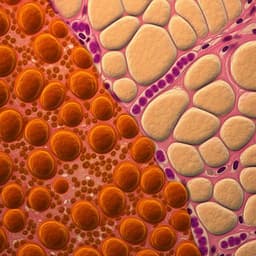
Medicine and Health
TANGO1 inhibitors reduce collagen secretion and limit tissue scarring
I. Raote, A. Rosendahl, et al.
Researchers including Ishier Raote and Ann-Helen Rosendahl have developed innovative membrane-permeant peptide inhibitors that target the TANGO1-cTAGE5 interaction, crucial for collagen export. This study uncovers promising strategies to modulate ECM hypersecretion, significantly reducing excessive scarring and fibrosis in zebrafish and human dermal cells.
~3 min • Beginner • English
Introduction
The study addresses the need for therapeutic strategies to reduce excessive extracellular matrix (ECM) deposition, particularly collagen, that underlies pathological scarring and fibrosis. After tissue injury, fibroblasts are activated by cytokines and growth factors to deposit ECM; fibrillar collagens constitute the main scar component. Despite advances in understanding fibrogenic signaling (e.g., IL-4 and TGFβ pathways), targeted inhibitors have shown limited efficacy likely due to redundancy across pathways. However, a common hallmark across fibrotic conditions is hypersecretion of ECM proteins. The authors propose modulating collagen deposition by targeting ER export mechanisms, focusing on TANGO1 and its paralog cTAGE5, master organizers of ER exit sites (ERES) required for collagen export across metazoans. By specifically disrupting the TANGO1–cTAGE5 interface, they aim to control collagen secretion and thereby limit scarring and fibrosis.
Literature Review
- Fibrotic diseases feature excessive ECM deposition; prior attempts to target individual profibrotic cytokine pathways (e.g., IL-4, TGFβ) have yielded disappointing antifibrotic outcomes, likely due to multiple convergent pathways.
- TANGO1 family proteins (TANGO1/MIA3 and cTAGE5) are essential for ER export of bulky cargo such as collagens in diverse species (mammals, Drosophila, zebrafish). TANGO1 organizes ERES and ER–ERGIC interfaces via luminal SH3-like and cytoplasmic interactions.
- Genetic loss of TANGO1 or cTAGE5 causes broad defects in collagen secretion and development, underscoring their central role in ECM secretion and suggesting them as tractable targets for modulating collagen export.
- Recent advances indicate that specific interactions among ERES machinery and cargoes can be selectively targeted, opening opportunities to modulate secretion without global toxicity.
Methodology
Design and synthesis of inhibitors:
- Used AlphaFold2 to predict the coiled-coil heterodimer structure of TANGO1 CC2 and cTAGE5 CC2 (UniProt TANGO1: Q5JRA6; cTAGE5: Q96PC5-7), indicating dimerization along the full length.
- Designed two competitive inhibitory peptides matching these CC2 regions: P2 (30 aa) and P5 (31 aa), each fused to a C-terminal 12-aa cell-penetrating/lysosomal escape motif GLRKRLRKFRNK for cytoplasmic delivery. Sequences: P2 LRQKVEILNELYQQKEMALQKKLSQEEYER-GLRKRLRKFRNK; P5 LEKEEKLSKVDEKISHATEELETYRKRAKDL-GLRKRLRKFRNK. Scrambled controls: scrP2 and scrP5 with identical composition but randomized order.
- Peptides synthesized by automated Fmoc/t-Bu SPPS on Rink amide resin; purified by RP-HPLC; identified by ESI-MS; final purity >50%; optional 5,6-carboxyfluorescein N-terminal labeling for uptake studies.
Cell lines and primary cells:
- U2OS (collagen I) and RDEB/FB/C7 fibroblasts (collagen VII) for ER retention assays; culture with ascorbate (250 µM ascorbic acid, 1 mM sodium/phospho-ascorbate) to promote procollagen export.
- Primary human dermal fibroblasts from healthy donors and scleroderma patients; passages 2–5. Activation with TGFβ1 (10 ng/ml) for 12 h prior to secretion assays.
Treatments and assays:
- Peptide treatments: commonly 40 µM (primary fibroblasts) for 20 h in serum-free medium; some assays used 100 µM (U2OS, RDEB/FB/C7) or combinations (P2+P5). Scrambled peptides up to 80 µM tested.
- Western blotting of cell lysates and supernatants for TANGO1, cTAGE5, (pro)collagen I/VII, fibrillin1, fibronectin; loading controls included β-tubulin, calnexin, GAPDH, Ponceau staining; ImageJ-based densitometry.
- Peptide uptake visualized by confocal/live fluorescence microscopy; ER co-staining (ER-RFP); quantification of intracellular fluorescence.
- LDH release assay to assess cytotoxicity.
- Secretome profiling by LC-MS/MS (Easy nLC 1000 coupled to QExactive Plus); MaxQuant/Andromeda searches; Perseus for statistics/GO; FDR <0.05; N=3.
- Duration of effect: after 20 h peptide treatment, peptides removed and cells incubated in serum-containing medium for 24/48/72 h; supernatant (pro)collagen I measured.
Zebrafish models:
- Embryo/larval treatment: AB wild-type embryos dechorionated at 2–4-cell stages; continuous incubation with P2+P5 at 2 or 4 µM (each) from early embryo to 3 dpf; imaging and phenotyping; larval length measured; SHG microscopy of de-yolked tail blades to analyze collagen fiber architecture; Directionality plugin in FIJI for fiber orientation/dispersion; Kolmogorov–Smirnov tests.
- Adult wound healing: 2 mm full-thickness flank wounds induced by Er:YAG laser; local microinjection of P2+P5 (estimated ~4 µM final in granulation tissue) or PBS at 2 and 3 dpw; analysis at 4 dpw by H&E histology for granulation tissue area, anti-type I collagen IF (Cy3) for collagen area; DAPI to count nuclei; TUNEL staining for apoptosis; ImageJ quantification; Student’s t-tests.
Statistics:
- Reported N values per experiment; tests included Student’s t-test (two-tailed), Mann–Whitney U test, Kolmogorov–Smirnov test, two-way ANOVA with Sidak’s multiple comparisons; significance thresholds * p<0.05, ** p<0.01, *** p<0.001, **** p<0.0001.
Key Findings
- Competitive peptides targeting the TANGO1–cTAGE5 CC2 interface (P2, P5) reduced endogenous TANGO1 and cTAGE5 protein levels in cells, consistent with destabilization upon heterodimer disruption (p<0.05 vs control; N=3 for TANGO1, N=5 for cTAGE5).
- In U2OS and RDEB/FB/C7 cells, P2/P5 caused ER retention of collagens I and VII, colocalizing with calnexin, while preserving TANGO1 localization to ERES (Sec31A colocalization), indicating specific inhibition of export rather than mislocalization.
- Primary human dermal fibroblasts: combined P2+P5 (40 µM each, 20 h) reduced secreted (pro)collagen I levels by more than 60% (N=24; Mann–Whitney U, two-tailed, **** p<0.0001). Single peptides (P2 or P5) did not significantly alter secretion at tested doses. Effect was reversible: strong inhibition at 24 h post-removal, mild at 48 h, absent by 72 h. Scrambled peptides had no effect up to 40 µM. No significant cytotoxicity detected by LDH assay; morphology and proliferation unaffected.
- Secretome analysis (N=3; FDR<0.05) showed significant reductions in multiple ECM proteins: collagens I (COL1A1, COL1A2), III (COL3A1), V (COL5A1), VI (COL6A2, COL6A3), XII (COL12A1); also non-collagen ECM components including versican (VCAN), fibrillin-1 (FBN1), fibronectin, and laminin α4 (LAMA4). GO analysis enriched for ECM structural components and collagen-related categories. Few proteins were increased; apparent increase in MIA3 reflected detection of added TANGO1-derived peptides.
- Zebrafish larvae treated with P2+P5 (2–4 µM each) from early embryo to 3 dpf were shorter and exhibited dose-dependent phenotypes (pooled/clotted blood, darkened yolk, blistered skin), consistent with TANGO1/cTAGE5 loss-of-function. SHG microscopy revealed disrupted collagen fiber organization with increased dispersion (KS test, *** p<0.001).
- Adult zebrafish wound model: local peptide injections reduced granulation tissue area (p=0.0369) and collagen deposition within granulation tissue (p=0.0006) at 4 dpw; nuclei density in granulation tissue slightly increased (p=0.0198); TUNEL analysis showed no significant difference in apoptosis vs control.
- In TGFβ-activated healthy fibroblasts and in scleroderma patient-derived fibroblasts, P2+P5 strongly reduced secretion of (pro)collagen I, fibrillin-1, and fibronectin, with pronounced effects under TGFβ stimulation (N=3).
Discussion
Targeted disruption of the TANGO1–cTAGE5 interaction at ER exit sites specifically attenuates export of bulky ECM cargoes, notably multiple collagens as well as fibrillin-1 and fibronectin, thereby addressing the central hallmark of fibrotic pathologies: ECM hypersecretion. The peptide inhibitors function across systems, from human cells to zebrafish, reducing collagen secretion without overt cytotoxicity and limiting granulation tissue and collagen deposition during wound healing in vivo. These findings validate ER export machinery as a druggable node for antifibrotic intervention and suggest that selective modulation of ERES function can achieve specificity, sparing general secretion. The observed reduction of TANGO1 and cTAGE5 protein levels upon treatment supports a model where heterodimer destabilization reduces complex stability, potentially extending antifibrotic effects beyond the intracellular presence of peptides until protein levels recover. The results are particularly relevant for conditions like scleroderma, where myofibroblasts remain activated and overproduce ECM; inhibiting TANGO1/cTAGE5 curtailed secretion of key fibrotic ECM proteins in patient-derived cells.
Conclusion
This work introduces membrane-permeant peptides that specifically target the TANGO1–cTAGE5 CC2 interface, demonstrating effective, selective inhibition of ER export of large ECM proteins. The inhibitors reduce collagen secretion in cell lines, primary human dermal fibroblasts (including TGFβ-activated and scleroderma-derived), perturb collagen fiber organization in zebrafish larvae, and decrease granulation tissue size and collagen deposition during zebrafish cutaneous wound healing without detectable toxicity. These findings provide proof-of-principle that modulating ERES function can therapeutically limit pathological ECM deposition and scarring. Future research should elucidate the precise biophysical disruption of TANGO1–cTAGE5 interactions, optimize peptide potency, stability, and purity, develop delivery strategies for localized tissue application (e.g., intralesional or topical), assess long-term efficacy and safety in mammalian fibrosis models, and explore whether other ECM components or modifying enzymes co-depend on TANGO1-mediated export.
Limitations
- Direct biophysical measurement of TANGO1–cTAGE5 interaction loss after peptide treatment was not achieved due to technical constraints; conclusions are inferred from reduced protein levels and functional outcomes.
- Peptide purity was reported as >50%, which may affect specificity and reproducibility; higher-purity preparations could refine interpretations.
- The peptides act locally and penetrate limited tissue depths, implying restricted distribution and necessitating localized delivery approaches; systemic effects were not evaluated.
- Most in vivo data are from zebrafish; translation to mammalian models and long-term safety remain to be established.
- Effects were transient in primary cells after peptide removal (diminished by 48–72 h), indicating the need for dosing strategies for sustained benefit.
Related Publications
Explore these studies to deepen your understanding of the subject.







